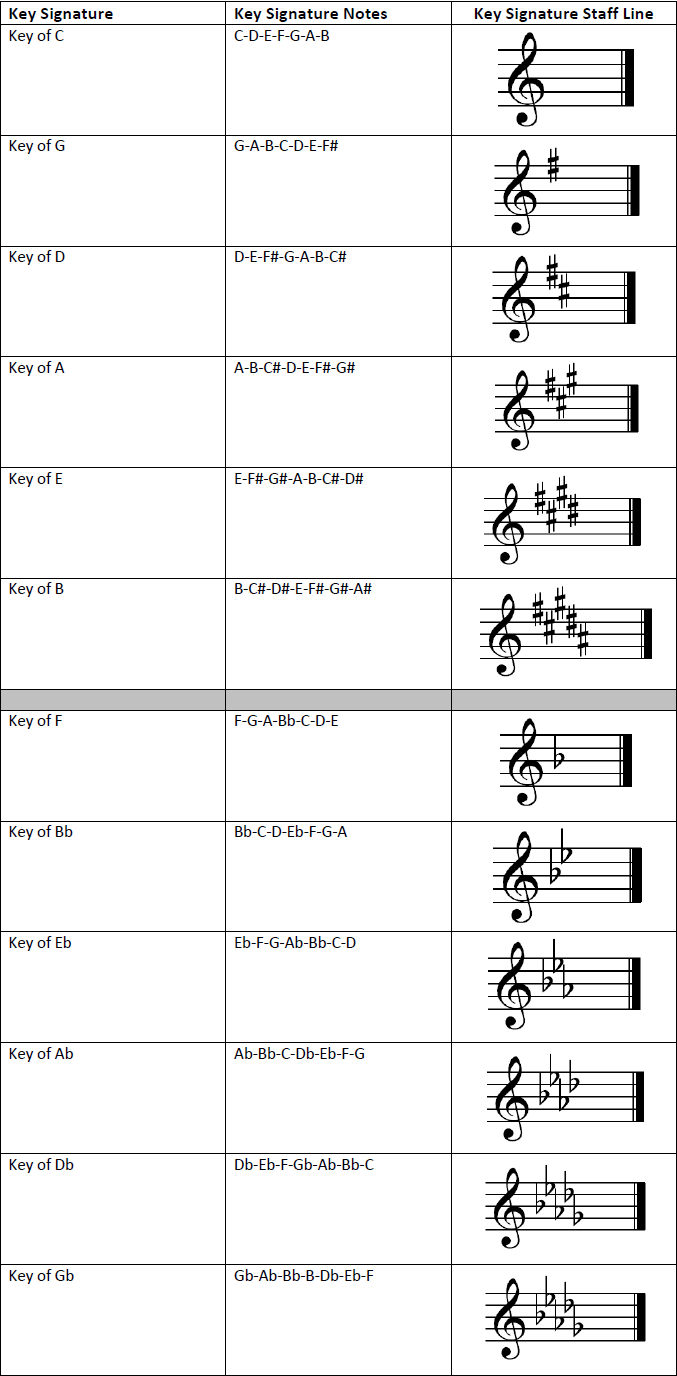Key Signatures are a very important concept to understanding the overall structure and form of songs and compositions. Key
signatures contain a great deal of information that helps composers write their music, and helps musicians understand it faster and more in-depth. In this
chapter, both sharp and flat key signatures will be explored for both major and minor scales. Also, the circle of fifths and fourths will be explored to
show how they will help utilize the full potential of key signatures.
Major Keys
The key signatures used in major keys are split in half between sharp keys and flat keys. These major keys share the same notes as major
scales. It is a good idea to look at the first line of a song, before the time signature, to see what key the song is in. This will help indicate
which notes will be most present in the song. Some songs will use the notes in a key signature throughout the whole song, while other songs will add
notes outside that key signature or even change key signatures.
This table 1 below shows all the major keys, their notes, and a staff line picture showing which notes are sharp and which are flat. Remember, the
notes in the key signature are the same as the corresponding major scale. The key of C shares the same notes as the C major scale.

Table 1 -
Major key signatures
Minor Keys
This next table 2 shows all the minor key signatures, their notes, and a staff line picture showing which notes are sharp and which are flat. Study
and memorize these key signatures as well.

Table 2 -
Minor key signatures
Step Numbers Determine Key Center
The
Key, or tonic center of a song can be determined by looking at the beginning of a song before the time signature, but they can be determined by scale step numbers as
well. For example, a song using the chord progression C-F-G can be compared to the harmonized major scale (I-ii-iii-IV-V-vi-vii), in which three major
chords match the key of C, I-IV-V chords (C-Dm-Em-F-G-Am-Bdim). Because major chords can only fall under the I, IV, and V steps, the key of C is the only
key that exactly matches the chord progression C-F-G. By testing the key of G chords (G-Am-Bm-C-D-Em-F#dim), the I-IV-V chords are G-C-D. Testing the
key of F chords (F-Gm-Am-Bb-C-Dm-Edim), the I-IV-V chords are F-Bb-C. Here is one more example: A-G#dim-F#m. Keeping in mind the seventh step is
always diminished (?-vii-?), the I step is always played as a major chord type and is a half step from the seventh step ( I-vii-?). This means the
A chord could not be a IV or V step chord. Consequentially, the F#m chord fits the vi step best because the vi step is a whole step from the vii
step. Furthermore, this means the F#m chord could not be a ii or iii step chord. As such, the A-G#dim-F#m (I-vii-vi) chord progression is in the
key of A.
These examples are a great exercise to practice determining what key a song is played in. Begin practicing simple chord progressions like
the examples above. Then, create more complex chord progressions, keeping in mind some chords in a chord progression may not come directly from the
key signature or harmonized major scale. By studying the song’s chord progression and
listening for the tonic cneter, a song’s key can
be quickly found.
Key Signature Builder
This exercise shows all Major Key Signatures, along with the notes in that key. Simply select the key from the listbox below.
 Key of C has the following notes:
Key of C has the following notes:
C, D, E, F, G, A, B